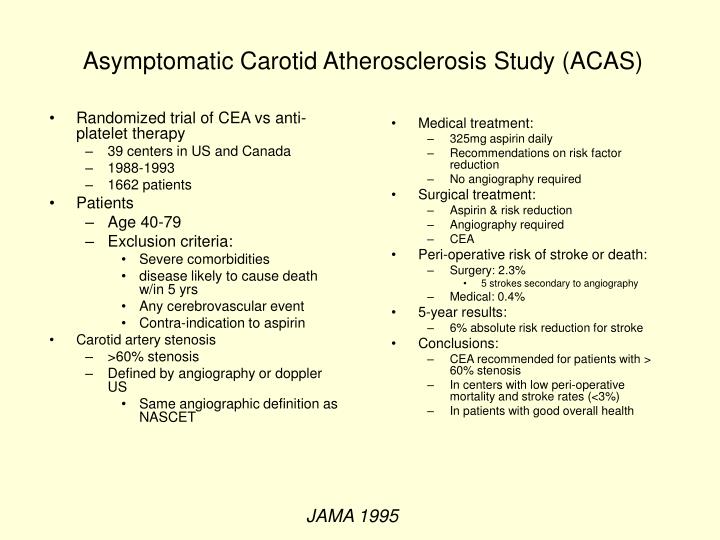Acas Carotid
Asymptomatic carotid artery stenosis (ACAS) Asymptomatic carotid artery stenosis (ACAS) 2011-04-01 00:00:00 J Neural Transm (2011) 118:629 DOI 10.1007/s00702-011-0634-5 COMMENTS Springer-Verlag 2011 For decades asymptomatic carotid artery stenosis (ACAS) Unlike symptomatic carotid stenosis, ACAS carries a has been a matter of debate. Among asymptomatic patients, the rate of stroke or death in the carotid-artery stenting group in our trial (2.5%) was similar to that in the Asymptomatic Carotid Atherosclerosis Study (ACAS) (2.3%. Asymptomatic carotid atherosclerotic disease, as discussed in this topic, refers to the presence of atherosclerotic narrowing of the proximal internal carotid artery at the bifurcation to 50 percent or more of the lumen diameter in individuals with no history of recent (within the last six months) ipsilateral carotid territory ischemic stroke or transient ischemic attack (TIA). The Asymptomatic Carotid Atherosclerosis Study Group. Study design for randomized prospective trial of carotid endarterectomy for asymptomatic atherosclerosis. Stroke 1989;20: 844 - 849.
Carotid arterial stenting (CAS) is a minimally invasive endovascular interventional procedure that can potentially offer the same advantage as surgery (carotid endarterectomy).

Indications
Indications for carotid stenting are evolving with endarterectomy trials that evaluate the carotid stenosis cutoff values for treatment. Currently, the indications include:
- symptomatic patients with ≥70% stenosis (NASCET trial)
- asymptomatic patients with >60% stenosis (ACAS study)
- symptomatic patients with stenosis of at least 50-69% stenosis
- carotid artery dissection or pseudoaneurysm
Contraindications
- complete carotid occlusion
- major disabling stroke on the ipsilateral side/disabling dementia
- intracranial tumor/hemorrhage
- unstable plaque or thick calcification at the site of carotid stenosis
- extreme tortuosity of the vessel
Complications

- preprocedural cerebrovascular accident (~8%) 3
- recurrent carotid arterial stenosis or in-stent restenosis (~6% at 1 year) 4
- hyperperfusion syndrome after carotid artery stenting (1-2%): headache, seizures and intracranial hemorrhage 6
Alternative treatment options
Acas Carotid Trial
Outcomes
Operator skills and experience have a profound impact on patient outcomes following CAS. One systematic review and meta-analysis of the literature found Carotid Endarectomy (CEA) to be superior to CAS in freedom from stroke/death within 30 days of treatment, with the incidence of stroke/death within 30 days of treatment was 4.7% for CAS and 3.5% for CEA 8.
History and etymology
- the first percutaneous transluminal carotid angioplasty (PTA) was performed by Charles Kerber in 1980 5.
- somewhat surprisingly the word 'stent' is actually an eponym, originally named after Charles Stent (1807-1885), a largely-forgotten British dentist. He invented an improved material for forming dental impressions and set up a company to manufacture it. During the Great War, J F Esser, a Dutch surgeon used a mold of Stent's Compound as a fixative for skin grafting in injured infantrymen. This innovative use was rapidly adopted into practice, and stenting as a concept rapidly segued into multiple specialties 7.
- 1. Baerlocher MO, Stewart B, Asch MR et-al. Performance of carotid stenting, vertebroplasty, and EVAR: how many are we doing and why are we not doing more? A survey by the Canadian Interventional Radiology Association. Can Assoc Radiol J. 2008;59 (1): 22-9. - Pubmed citation
- 2. Sacks D, Connors JJ. Carotid stent placement, stroke prevention, and training. Radiology. 2005;234 (1): 49-52. doi:10.1148/radiol.2341041628 - Pubmed citation
- 3. Pelz D, Andersson T, Soderman M et-al. Advances in interventional neuroradiology 2005. Stroke. 2006;37 (2): 309-11. doi:10.1161/01.STR.0000201436.30248.ec - Pubmed citation
- 4. Gröschel K, Riecker A, Schulz JB et-al. Systematic review of early recurrent stenosis after carotid angioplasty and stenting. Stroke. 2005;36 (2): 367-73. doi:10.1161/01.STR.0000152357.82843.9f - Pubmed citation
- 5. Liistro F, Di Mario C. Carotid artery stenting. Heart. 2003;89 (8): 944-8. doi:10.1136/heart.89.8.944 - Free text at pubmed - Pubmed citation
- 6. Karapanayiotides T, Meuli R, Devuyst G et-al. Postcarotid endarterectomy hyperperfusion or reperfusion syndrome. Stroke. 2004;36 (1): 21-6. doi:10.1161/01.STR.0000149946.86087.e5 - Pubmed citation
- 7. Stenting. (2001) Surgical Endoscopy. 15 (4): 423. doi:10.1007/s004640080116 - Pubmed
- 8. Zhang L et. al. Systematic Review and Meta-Analysis of Carotid Artery Stenting Versus Endarterectomy for Carotid Stenosis: A Chronological and Worldwide Study. (2015) Medicine. doi:10.1097/MD.0000000000001060 - Pubmed
Promoted articles (advertising)
Karen L Furie, MD, MPH
- Chair and Professor of Neurology
- Alpert Medical School of Brown University
Scott E Kasner, MD
- Section Editor — Stroke
- Professor of Neurology
- University of Pennsylvania School of Medicine
John F Eidt, MD
- Section Editor — Vascular and Endovascular Surgery
- Professor of Surgery, Texas A&M Health Science Center
- Vice Chair of Vascular Surgical Services, Baylor Heart and Vascular Hospital at Dallas
Acas Carotid Study
Joseph L Mills, Sr, MD
- Section Editor — Vascular and Endovascular Surgery
- Professor and Chief
- Division of Vascular Surgery and Endovascular Therapy
- Baylor College of Medicine

- Deputy Editor
- John F Dashe, MD, PhD
INTRODUCTION
Computed tomographic (CT) scanning and magnetic resonance imaging (MRI) are useful for evaluating the question of cerebral infarction which may result from carotid artery stenosis. Infarctions related to internal carotid artery stenosis may be deep, subcortical, or cortical. However, carotid stenosis may exist in the absence of infarction on MRI and CT.
The definition of asymptomatic or symptomatic carotid artery stenosis is based upon the history and physical examination, depending upon whether or not there are symptoms or signs of carotid territory ischemia. In the large clinical trials addressing the management of carotid artery stenosis, the detection of 'silent' infarcts on CT or MRI did not qualify the stenosis as symptomatic. In clinical practice, however, radiographic evidence of ischemia in the territory of a stenotic internal carotid artery may affect management.
Four diagnostic modalities are used to directly image the internal carotid artery:
●Cerebral angiography
●Carotid duplex ultrasound
Acas Carotid Trial

Subscribers log in here